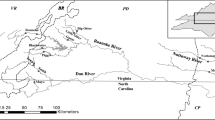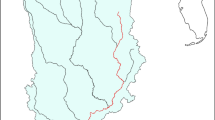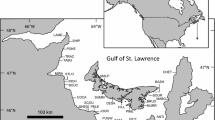Abstract
Crayfish are ecologically important in freshwater systems worldwide and are imperiled in North America and globally. We sought to examine landscape- to local-scale environmental variables related to occupancy and detection probability of a suite of stream-dwelling crayfish species. We used a quantitative kickseine method to sample crayfish presence at 102 perennial stream sites with eight surveys per site. We modeled occupancy (psi) and detection probability (P) and local- and landscape-scale environmental covariates. We developed a set of a priori candidate models for each species and ranked models using (Q)AICc. Detection probabilities and occupancy estimates differed among crayfish species with Orconectes eupunctus, O. marchandi, and Cambarus hubbsi being relatively rare (psi < 0.20) with moderate (0.46–0.60) to high (0.81) detection probability and O. punctimanus and O. ozarkae being relatively common (psi > 0.60) with high detection probability (0.81). Detection probability was often related to local habitat variables current velocity, depth, or substrate size. Important environmental variables for crayfish occupancy were species dependent but were mainly landscape variables such as stream order, geology, slope, topography, and land use. Landscape variables strongly influenced crayfish occupancy and should be considered in future studies and conservation plans.



Similar content being viewed by others
References
Allison, P. D., 2008. Convergence failures in logistic regression. [available on internet at http://www2.sas.com/proceedings/forum2008/360-2008.pdf]. Accessed September 2016.
Arkansas Game and Fish Commission, 2016. Calculated priority scores for crayfish species of greatest conservation need. Arkansas State Wildlife Action Plan. Little Rock, AR. [available on internet at http://www.agfc.com/species/Pages/SpeciesWildlifeActionPlan.aspx]. Accessed September 2016.
Arkansas Natural Heritage Commission, 2016. Research and data; species rank and status. [available on internet at http://www.naturalheritage.com/Research-and-Data/rare-species-search]. Accessed September 2016.
Bailey, L. L., T. R. Simons & K. H. Pollock, 2004. Estimating site occupancy and species detection probability parameters for terrestrial salamanders. Ecological Applications 14: 692–702.
Banks-Leite, C., R. Pardini, D. Boscolo, C. R. Cassano, T. Puttker, C. S. Barros & J. Barlow, 2014. Assessing the utility of statistical adjustments for imperfect detection in tropical conservation science. Journal of Applied Ecology 51: 849–859.
Charlebois, P. M. & G. A. Lamberti, 1996. Invading crayfish in a Michigan stream: direct and indirect effects on periphyton and macroinvertebrates. Journal of the North American Benthological Society 15: 551–563.
Creed, R. P., 1994. Direct and indirect effects of crayfish grazing a stream community. Ecology 75: 2091–2103.
DiStefano, R. J., 2005. Trophic interactions between Missouri Ozarks stream crayfish communities and sport fish predators: increased abundance and size structure of predators cause little change in crayfish community densities. Missouri Department of Conservation, Dingell-Johnson Project F-1-R-054, Study S-41, Job 4, Final Report. Columbia, MO.
DiStefano, R. J., D. D. Magoulick, E. M. Imhoff & E. R. Larson, 2009. Imperiled crayfishes use hyporheic zone during seasonal drying of an intermittent stream. Journal of the North American Benthological Society 28: 142–152.
Elith, J. & J. R. Leathwick, 2009. Species distribution models: ecological explanation and prediction across space and time. Annual Review of Ecology, Evolution and Systematics 40: 677–697.
Engelbert, B. S., C. A. Taylor & R. J. DiStefano, 2016. Development of standardized stream-dwelling crayfish sampling methods at site and drainage scales. North American Journal of Fisheries Management 36: 104–115.
Fiske, I. J. & R. B. Chandler, 2011. Unmarked: an R package for fitting hierarchical models of wildlife occurrence and abundance. Journal of Statistical Software 43: 1–23.
Flinders, C. A. & D. D. Magoulick, 2003. Effects of stream permanence on crayfish community structure. American Midland Naturalist 149: 134–147.
Flinders, C. A. & D. D. Magoulick, 2005. Distribution, habitat use and life history of stream-dwelling crayfish in the spring river drainage of Arkansas and Missouri with a focus on the imperiled Mammoth Spring Crayfish (Orconectes marchandi). American Midland Naturalist 154: 358–374.
Flinders, C. A. & D. D. Magoulick, 2007. Habitat use and selection within Ozark lotic crayfish assemblages: spatial and temporal variation. Journal of Crustacean Biology 27: 242–254.
Frisch, J. R., J. T. Peterson, K. K. Cecala, J. C. Maerz, C. R. Jackson, T. L. Gragson & C. M. Pringle, 2016. Patch occupancy of stream fauna across a land cover gradient in the southern Appalachians, USA. Hydrobiologia 773: 163–175.
Grant, E. H. C., A. N. M. Wiewel & K. C. Rice, 2014. Stream-water temperature limits occupancy of salamanders in mid-Atlantic protected areas. Journal of Herpetology 48: 45–50.
Guillera-Arroita, G., J. J. Lahoz-Monfort, D. I. MacKenzie, B. A. Wintle & M. A. McCarthy, 2014. Ignoring imperfect detection in biological surveys is dangerous: a response to ‘fitting and interpreting occupancy models’. Plos One 9: e99571.
Guisan, A. & N. E. Zimmermann, 2000. Predictive habitat distribution models in ecology. Ecological Modelling 135: 147–186.
Imhoff, E. M., M. J. Moore & R. J. DiStefano, 2012. Introduced alien ringed crayfish (Orconectes neglectus neglectus [Faxon, 1885]) threaten imperiled coldwater crayfish (Orconectes eupunctus Williams, 1952) in the Eleven Point River drainage, Missouri, USA. Aquatic Invasions 7: 129–134.
Kawai, T., Z. Faulkes & G. Scholtz, 2015. Freshwater crayfish: a global overview. CRC Press, Boca Raton.
Kirsch, J. E. & J. T. Peterson, 2014. A multi-scaled approach to evaluating the fish assemblage structure within southern Appalachian streams. Transactions of the American Fisheries Society 143: 1358–1371.
Larson, E. R. & J. D. Olden, 2013. Crayfish occupancy and abundance in lakes of the Pacific Northwest, USA. Freshwater Science 32: 94–107.
Larson, E. R. & J. D. Olden, 2016. Field sampling techniques for crayfish. In Longshaw, M. & P. Stebbing (eds), Biology and Ecology of Crayfish. CRC Press, Boca Raton: 287–324.
Larson, E. R., D. D. Magoulick, C. Turner & K. H. Laycock, 2009. Disturbance and species displacement: different tolerances to stream drying and desiccation in a native and an invasive crayfish. Freshwater Biology 54: 1899–1908.
Loughman, Z. J., S. A. Welsh, N. M. Sadecky, Z. W. Dillard & R. K. Scott, 2016. Environmental covariates associated with Cambarus veteranus Faxon, 1914 (Decapoda: Cambaridae), an imperiled Appalachian crayfish endemic to West Virginia, USA. Journal of Crustacean Biology 36: 642–648.
Mackenzie, D., J. Nichols, J. Royle, K. Pollock, L. Bailey & J. Hines, 2006. Occupancy Estimation and Modeling: Inferring Patterns and Dynamics of Species Occurrence. Elsevier, New York.
Magoulick, D. D. & R. J. DiStefano, 2007. Invasive crayfish Orconectes neglectus threatens native crayfishes in the Spring River drainage of Arkansas and Missouri. Southeastern Naturalist 6: 141–150.
Magoulick, D. D. & G. L. Piercey, 2016. Trophic overlap between native and invasive stream crayfish. Hydrobiologia 766: 237–246.
Mather, M. E. & R. A. Stein, 1993. Direct and indirect effects of fish predation on the replacement of a native crayfish by an invading congener. Canadian Journal of Fisheries and Aquatic Sciences 50: 1279–1288.
Program, Missouri Natural Heritage, 2016. Missouri Species and Communities of Conservation Concern Checklist. Missouri Department of Conservation, Jefferson City.
Momot, W. T., 1995. Redefining the role of crayfish in aquatic ecosystems. Reviews in Fisheries Sciences 3: 33–63.
Nolen, M. S., D. D. Magoulick, R. J. Distefano, E. M. Imhoff & B. K. Wagner, 2014. Predicting probability of occurrence and factors affecting distribution and abundance of three Ozark endemic crayfish species at multiple spatial scales. Freshwater Biology 59: 2374–2389.
Parvulescu, L., C. Zaharia, A. Satmari & L. Dragut, 2013. Is the distribution pattern of the stone crayfish in the Carpathians related to karstic refugia from Pleistocene glaciations? Freshwater Science 32: 1410–1419.
Pearl, C. A., M. J. Adams & B. McCreary, 2013. Habitat and co-occurrence of native and invasive crayfish in the Pacific Northwest, USA. Aquatic Invasions 8: 171–184.
R Core Team, 2016. R: a language and environment for statistical computing. R Foundation for Statistical Computing, Vienna, Austria [available on internet at https://www.R-project.org/].
Rabeni, C. F., M. Gossett & D. D. McClendon, 1994. Contribution of crayfish to benthic invertebrate production and trophic ecology of an Ozark stream. Freshwater Crayfish 10: 163–173.
Richman, N. I., M. Boehm, S. B. Adams et al., 2015. Multiple drivers of decline in the global status of freshwater crayfish (Decapoda: Astacidea). Philosophical Transactions of the Royal Society B 370.
Rosewarne, P. J., R. J. G. Mortimer, R. J. Newton, C. Grocock, C. D. Wing & A. M. Dunn, 2016. Feeding behaviour, predatory functional responses and trophic interactions of the invasive Chinese mitten crab (Eriocheir sinensis) and signal crayfish (Pacifastacus leniusculus). Freshwater Biology 61: 426–443.
Royle, J. A. & J. D. Nichols, 2003. Estimating abundance from repeated presence-absence data or point counts. Ecology 84: 777–790.
Sauerbrei, W., P. Royston & H. Binder, 2007. Selection of important variables and determination of functional form for continuous predictors in multivariable model building. Statistics in Medicine 26: 5512–5528.
Sepulveda, A. J. & W. H. Lowe, 2009. Local and landscape-scale influences on the occurrence and density of Dicamptodon aterrimus, the Idaho Giant Salamander. Journal of Herpetology 43: 469–484.
Sowa, S. P., G. Annis, M. E. Morey & D. D. Diamond, 2007. A gap analysis and comprehensive conservation strategy for riverine ecosystems of Missouri. Ecological Monographs 77: 301–334.
Strahler, A. N., 1957. Quantitative analysis of watershed geomorphology. Transactions of the American Geophysical Union 38: 913–920.
Taylor, C. A., G. A. Schuster, J. E. Cooper, et al., 2007. Feature: Endangered species – a reassessment of the conservation status of crayfishes of the United States and Canada after 10 + years of increased awareness. Fisheries 32: 372–389.
U.S. Fish and Wildlife Service, 2016a. Species profile for coldwater crayfish (Orconectes eupunctus). Environmental conservation online system. [available on internet at http://ecos.fws.gov/ecp0/profile/speciesProfile?sId=9815]. Accessed September 2016.
U.S. Fish and Wildlife Service, 2016b. Species profile for mammoth spring crayfish (Orconectes marchandi). Environmental conservation online system. [available on internet at http://ecos.fws.gov/ecp0/profile/speciesProfile?sId=9823]. Accessed September 2016.
Welsh, A. H., D. B. Lindenmayer & C. F. Donnelly, 2013. Fitting and interpreting occupancy models. Plos One 8: e52015.
Welsh, S. A. & Z. J. Loughman, 2015. Physical habitat and water quality correlates of crayfish distributions in a mined watershed. Hydrobiologia 745: 85–96.
Westhoff, J. T., J. A. Guyot & R. J. DiStefano, 2006. Distribution of the imperiled Williams’ crayfish (Orconectes williamsi) in the White River drainage of Missouri: Associations with multi-scale environmental variables. American Midland Naturalist 156: 273–288.
Whitledge, G. W. & C. F. Rabeni, 1997. Energy sources and ecological role of crayfishes in an Ozark stream: insights from stable isotopes and gut analysis. Canadian Journal of Fisheries and Aquatic Sciences 54: 2555–2563.
Acknowledgements
We thank K. Bradley, J. Brittain, J. Evans, B. Freeland, H. Ladd, M. Mabery, J. Stroman, A. VanStrien, and M. Vincenti for their efforts in field work. Thanks to D. Swedberg for figure help. A. Yarra, N. Graham, M. Moore and two anonymous reviewers made helpful comments on the manuscript. Funding was provided by a grant from Missouri Department of Conservation. Any use of trade, firm, or product names is for descriptive purposes only and does not imply endorsement by the U.S. Government.
Author information
Authors and Affiliations
Corresponding author
Additional information
Handling editor: Eric R. Larson
Rights and permissions
About this article
Cite this article
Magoulick, D.D., DiStefano, R.J., Imhoff, E.M. et al. Landscape- and local-scale habitat influences on occupancy and detection probability of stream-dwelling crayfish: implications for conservation. Hydrobiologia 799, 217–231 (2017). https://doi.org/10.1007/s10750-017-3215-2
Received:
Revised:
Accepted:
Published:
Issue Date:
DOI: https://doi.org/10.1007/s10750-017-3215-2




